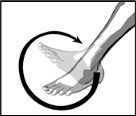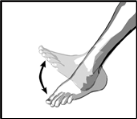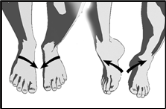After your plaster has been removed
The information on this page is to prepare you for when your plaster has been removed. Although you will be keen to resume normal activities there may be a few adjustments that you will need to make.
Following the removal of your plaster
After your plaster has been removed you may:
- feel faint or nauseous (sick) – do not be worried as this is common and will settle quickly.
- feel as though your limb is light and weak.
- notice that the limb looks thin and odd.
- have dry and flaky skin.
- find that your limb feels stiff and painful.
- discover that the limb is now more hairy.
All of these will reduce over the next few days.
Additional information
A break and a fracture are the same and means you have a broken bone. It may be called by either term.
An X-ray is not always needed to decide if the fracture has healed. The doctor can tell by examining your limb.
Physiotherapy is not always necessary.
Exercises for your wrist
The following exercises may be helpful for your wrist.
1. Bend your wrist forwards and backwards as far as possible.

2. Keeping your forearm still, move your hand from side to side.

3. Keeping your fingers straight, spread your fingers and thumb as far apart as possible, then press them together.
4. Try and make a tight fist including your thumb.
5. In turn, touch the tip then the base of each of your fingers.
Do not lift heavy objects or containers of hot liquid until your hand and wrist are strong and you feel sure that you can do it.
Your ankle
Once your plaster has been removed it is common to experience aching in the foot and ankle. You may also have some stiffness and in cold weather some blueness.
Swelling may happen for several months particularly in the ankle. Therefore, you must elevate (raise) your leg when resting. This should be as high as your heart. Exercising your ankle will also help to reduce any swelling.
Walking
If you have been told to put weight through your leg, try to walk as normally as possible. When stepping forward, your heel should touch the ground first, followed by the outer border of your foot and then your toes. Hospital staff will tell you how much weight you can put through your leg.
Exercises for your ankle
Regular exercise to restore movement and muscle strength around the foot and ankle is very important.
1. In a sitting position or lying on your back. Circle your ankle and foot in one direction and then the other.

2. In a sitting position or lying on your back. Move your foot up and down at the ankle. Try to move as far as you can in each direction.

3. Sitting with your foot on the floor. Turn the soles of the feet in towards each other then turn them away from each other.

Swimming would also be a good form of exercise.
Contact information
If you have any problems after discharge, please contact your GP or the Fracture Clinic for advice.
Fracture Clinic
Cheltenham General Hospital
Tel: 0300 422 3863
Monday to Friday, 9:00am to 5:00pm
Gloucestershire Royal Hospital
Tel: 0300 422 8409
Monday to Friday, 9:00am to 5:00pm
Out of our hours ring NHS 111 for advice
NHS 111
Tel: 111
Orthopaedic Outpatients Appointments
Cheltenham General Hospital
Tel: 0300 422 3147
Gloucestershire Royal Hospital
Tel: 0300 422 8409
Plaster Room
Cheltenham General Hospital
Tel: 0300 422 3148
Gloucestershire Royal Hospital
Tel: 0300 422 8411